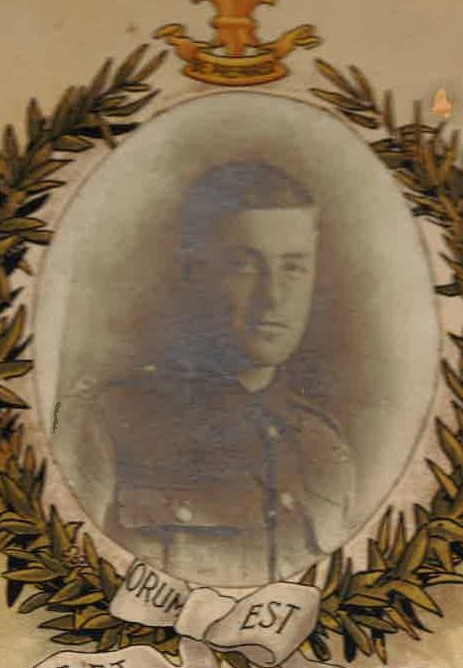Pte
John Watson
Information about birth
|
Date of birth: 31/12/1892 |
|
Place of birth: Wakefield, Yorkshire, England, United Kingdom |
General information
|
Profession: Colliery Wagon Builder |
Army information
|
Country: England, United Kingdom |
|
Force: British Expeditionary Force |
|
Rank: Private |
|
Service number: 50405 |
|
Enlistment place: Wakefield, Yorkshire, England, United Kingdom |
|
Units: — North Staffordshire Regiment, 8th Bn. (Last known unit) |
Information about death
|
Date of death: 04/10/1917 |
|
Place of death: Bitter Wood Geluveld, Belgium |
|
Cause of death: Killed in action (K.I.A.) |
|
Age: 24 |
Cemetery
|
Ypres Reservoir Cemetery Plot: VII Row: C Grave: 12 |
Distinctions and medals 2
|
British War Medal Medal |
|
Victory Medal Medal |
Points of interest 3
| #1 | Place of birth | ||
| #2 | Enlistment place | ||
| #3 | Place of death (approximate) |
My story
John Watson was born on New Year's Eve 1892. According to the 1911 census, John worked as Colliery Wagon Builder in Wakefield, Yorkshire. His father William and brother Joe worked in the same coal mine. John was an assistant scoutmaster with the 1st Wakefield (City) troop. During the war he enlisted voluntarily and by the time of the Battle of Passchendaele John served in the North Staffordshire Regiment, 8th Battalion, part of the 57th Brigade of the 19th (Western) Division.
On the 1st of October 1917 the Division held frontline positions in Bitter Wood, between Shrewsbury Forest and the Menin Road. The Bassevillebeek stream formed the boundary between the 8th North Staffordshires’ and the 37th Division on their left.
During the Battle of Broodseinde on 4 October 1917 the 19th (Western) Division covered the attack of the 37th Division, which advanced directly south of the Menin Road towards the village of Geluveld. When the attack on the left developed, John’s Battalion was heavily shelled by the German artillery. “A” Company in support took the full brunt of the barrage.
The battered Battalion was relieved under the cover of darkness. When the 8th North Staffordshires’ arrived at their camp, they counted 57 casualties during their tour in the frontline at Bitter Wood.
John Watson, 24, was killed in action on 4 October 1917 when his Battalion held the line at Bitter Wood. He left behind a wife and a young daughter. John was buried in Bitter Wood. His remains were interred in Ypres Reservoir Cemetery after the war.
On the 1st of October 1917 the Division held frontline positions in Bitter Wood, between Shrewsbury Forest and the Menin Road. The Bassevillebeek stream formed the boundary between the 8th North Staffordshires’ and the 37th Division on their left.
During the Battle of Broodseinde on 4 October 1917 the 19th (Western) Division covered the attack of the 37th Division, which advanced directly south of the Menin Road towards the village of Geluveld. When the attack on the left developed, John’s Battalion was heavily shelled by the German artillery. “A” Company in support took the full brunt of the barrage.
The battered Battalion was relieved under the cover of darkness. When the 8th North Staffordshires’ arrived at their camp, they counted 57 casualties during their tour in the frontline at Bitter Wood.
John Watson, 24, was killed in action on 4 October 1917 when his Battalion held the line at Bitter Wood. He left behind a wife and a young daughter. John was buried in Bitter Wood. His remains were interred in Ypres Reservoir Cemetery after the war.
Sources 6
|
"Passchendaele Day-by-Day Account", McCarthy C.,Uniform, 2018, page 107 Sources used |
|
"The Nineteenth division 1914 - 1918", Wyrall E., The Naval & Military Press, s.d., page 118 - 119 Sources used |
|
Ancestry https://search.ancestry.co.uk/cgi-bin/sse.dll?indiv=1&dbid=1543&h=550066&tid=&pid=&usePUB=true&_phsrc=RqK1&_phstart=successSource Further reference |
|
CWGC https://www.cwgc.org/find-war-dead/casualty/99890/watson,-/ Sources used |
|
The long, Long Trail https://www.longlongtrail.co.uk/army/ Sources used |
|
War Diary http://www.nmarchive.com/view-diary/trenches/2085-1977/606840 Further reference |
